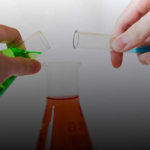Section 1
Preview this deck
soluble
Front
Active users
0
All-time users
0
Favorites
0
Last updated
4 years ago
Date created
Mar 14, 2020
Cards (65)
Section 1
(50 cards)
soluble
Capable of being dissolved
anion
A negatively charged ion
ionic compound
A compound that consists of positive and negative ions
calorie
Amount of energy needed to raise temperature 1 gram of water 1 degree C
actual yield
the measured amount of a product of a reaction
spectator ion
an ion that appears on both sides of an equation and is not directly involved in the reaction
Lewis dot model
Lewis structures (also known as Lewis dot diagrams, electron dot diagrams, Lewis dot formulas, Lewis dot structures, and electron dot structures) are diagrams that show the bonding between atoms of a molecule and the lone pairs of electrons that may exist in the molecule.
excess reagent
the reactant that is not completely used up in a reaction
thermodynamics
The study of energy transformations that occur in a collection of matter.
strong acid
An acid that ionizes completely in aqueous solution
combustion
A type of chemical reaction in which a fuel combines with oxygen to produce heat, light, CO2 (carbon dioxide), and H2O (water). hydrocarbon + oxygen ----> carbon dioxide + water
empirical formula
a chemical formula showing the ratio of elements in a compound rather than the total number of atoms
pH
An organism's physical appearance or visible traits
Avogadro's number
6.02x10^23
percent by volume
volume of solute/volume of solution x 100%
covalent compound
a chemical compound formed by the sharing of electrons
naming ionic and covalent compounds
Ionic: Between metals and nonmetals (normal) ide ending. Ionic: transition metal and a nonmetals- roman numerals for the charge. Covalent: between non-metals, use prefixes-mono, di, tri, tetra, penta, hexa, hepta, octa, nona, deca. (ALL THREE END IN -IDE)
mole
the simplest structural unit of an element or compound
joules
unit of energy
electronegitivity
the relative ability of an atom in a molecule to attract shared electrons to its self
solute
A substance that is dissolved in a solution.
reactants
A starting material in a chemical reaction
atomic number
Number of protons in the nucleus of an atom
gay-lussac's law
the pressure of a gas is directly proportional to the Kelvin temperature if the volume is kept constant. P1/T1=P2/T2
percent by mass
Mass of solute/mass of solution x 100
products
The elements or compounds produced by a chemical reaction.
precipitate
a solid that forms from solution during a chemical reaction
spontaneous reaction
A reaction that will proceed or occur on its own without an input of energy from its surroundings.
limiting reagent
any reactant that is used up first in a chemical reaction; it determines the amount of product that can be formed in the reaction
solvent
A liquid substance capable of dissolving other substances
ideal gas law
law that states the math relationship of pressure (P), volume (V), temperature (T), the gas constant (R), and the number of moles of a gas (n) PV=nRT.
cation
A positively charged ion
percent yield
the ratio of the actual yield to the theoretical yield expressed as a percent
molecular formula
A chemical formula that shows the number and kinds of atoms in a molecule, but not the arrangement of the atoms.
combined gas law
the law that describes the relationship among the pressure, temperature, and volume of an enclosed gas. P1V1/T1=P2V2/T2
molality
the concentration of a solution expressed in moles of solute per kilogram of solvent
stiochiometry
the study of the quantitative relationships that exist in chemical reactions
molar mass
the mass of one mole of a substance
balancing equations
the reactants and products are being set equal to one another
oxyacid
any acid that contains hydrogen and an oxyanion
specific heat
The amount of energy required to raise the temperature of 1 gram of a substance by 1 degree celcius
Charles law
the law that states that for a fixed amount of gas at a constant pressure, the volume of the gas increases as the temperature of the gas increases and the volume of the gas decreases as the temperature of the gas decreases. V1/T1=V2/T2
boyle's law
The relationship between the pressure and volume of a gas at constant temperture; when volume increase, pressure decreases. P1V1=P2V2
theoretical yield
the maximum amount of product that can be produced from a given amount of reactant
noble gas
an unreactive group, group 18 of the periodic table
molarity
A concentration unit of a solution expressed as moles of solute dissolved per liter of solution
atomic mass
The average mass of all the isotopes of an element
Hess's law
a statement in chemistry: the heat change in a chemical reaction is the same regardless of the number of stages in which the reaction is effected.
molar ratio
ratio of coefficients in a chemical equation
weak acid
an acid that is only slightly ionized in aqueous solution
Section 2
(15 cards)


